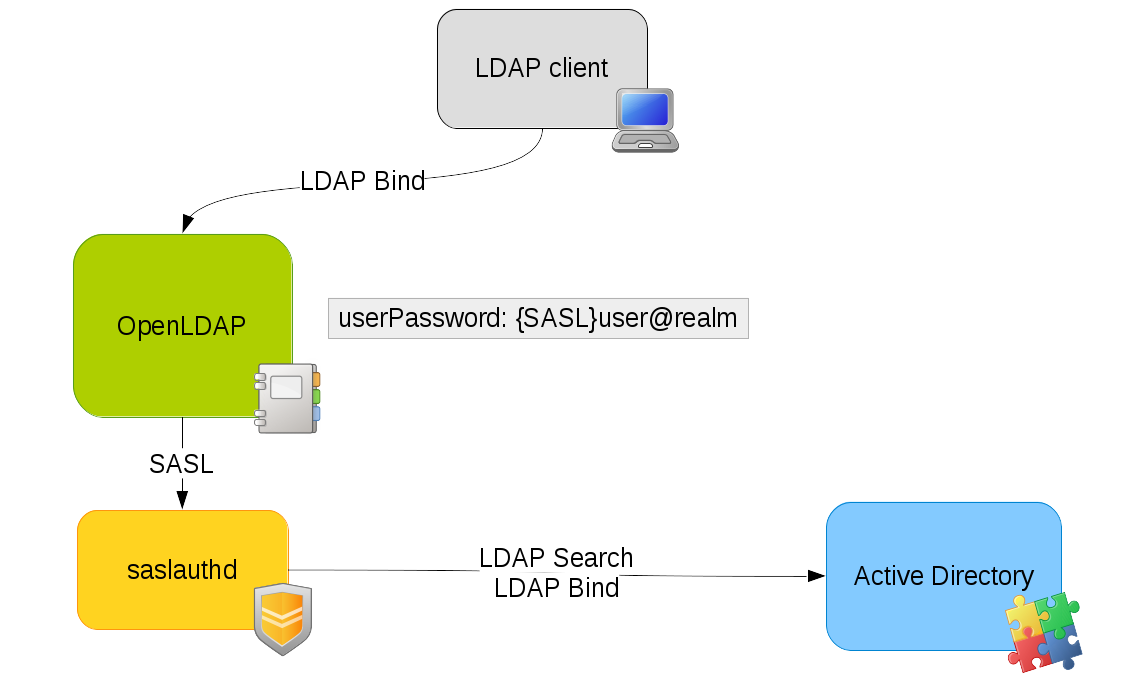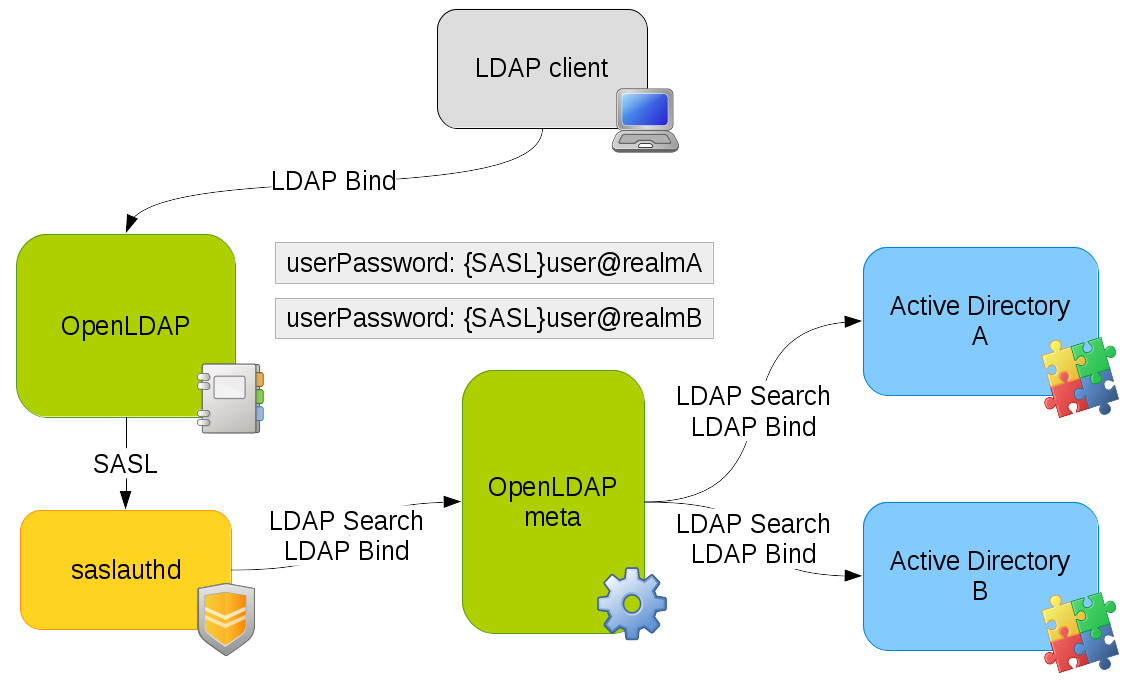Pass-Through authentication with SASL
Presentation
Pass-Through authentication is a mechanism used by some LDAP directories to delegate authentication operations (BIND) to other backends.
It should be distinguished from the external authentication methods, that are managed by the LDAP client to authenticate on a trusted source and then connect to the directory.
Pass-Through authentication is purely transparent for LDAP clients, as they send standard authentication operations to the LDAP directory, which will then handle the delegation and forward the response to the client, as if the authentication had occured locally.
A real world use case is the coexistence between OpenLDAP and Active Directory: a notable scenario could be to let the password into AD, and configure a pass-through authentication between OpenLDAP and AD. With this setup, authentications done on the OpenLDAP are actually delegated to Active Directory.
There are two different solutions for setting up delegation of authentication:
There are some differences between these solutions:
SASL method has 3 layers: OpenLDAP — SASL daemon — 3rd party LDAP, whereas remoteauth has 2: OpenLDAP — 3rd party LDAP
SASL method allows more fine-grain configuration: domain set-up in the user password, LDAP search options to the 3rd party LDAP, timeout,…, but requires the meta or LDAP backend for dealing with multiple directories
remoteauth method is designed for managing multiple directories, grouped by domain. This requires constraints on the LDAP data: delegation is triggered globally for every entry with no userPassword and requires additional attributes for storing the user domain and DN
remoteauth is recommended by OpenLDAP core team
Technical description
OpenLDAP is known to be able to use pass-through authentication. This option should be compiled into it. If not, get the sources and use this option in the configure step:
./configure --enable-spasswd --with-cyrus-sasl
This will allow you to store password with this syntax in userPassword attribute: userPassword: {SASL}user@domain
This option is enabled by default in LDAP Tool Box OpenLDAP packages
Then you need the saslauthd daemon, which is available on most Linux distributions.
The pass-through authentication will then work like this:
A BIND operation is received by OpenLDAP with parameters DN1 and PWD1
OpenLDAP get DN1 entry and read userPassword attribute
DN1 password is a SASL password so OpenLDAP do a SASL authentication with
user@domainand PWD1 credentialsSASL authentication daemon use the credentials to look for the user into the backend (for example Active Directory) and gets the matching DN, DN2
SASL do a BIND operation with DN2 and PWD1
The backend manage the BIND and return response to SASL
SASL returns authentication status to OpenLDAP (yes/no)
OpenLDAP returns response to the LDAP client
Pass-Through authentication on one LDAP directory

Tip
This is the standard use case: the password is stored in a directory and other LDAP directories delegate authentication to it.
Note
This chapter allows you to use several LDAP directories as authentication backend, but only for redundancy problems: all directories will have the same data inside. To see how use several directories with different data models, go to next chapter.
Step 1: connection to the backend
You need to get all connection parameters to the authentication backend. An example with Active Directory:
- Server address:
ldap://ad.example.com- Bind DN:
CN=Administrator,CN=Users,DC=example,DC=com- Bind Password:
ADpassword- Users branch:
CN=DomainUsers,DC=example,DC=com
You can check these settings with an ldapsearch:
ldapsearch -x -H ldap://ad.example.com -D CN=Administrator,CN=Users,DC=example,DC=com -w ADpassword -b CN=DomainUsers,DC=example,DC=com
Step 2: configure saslauthd
First, check that your SASL daemon supports LDAP:
saslauthd -v
If not, reinstall an LDAP-aware saslauthd daemon.
For RHEL:
yum install cyrus-sasl
For Debian:
apt install sasl2-bin
Then to activate LDAP as SASL mechanism on Red-Hat systems:
vi /etc/sysconfig/saslauthd
SOCKETDIR=/var/run/saslauthd
MECH=ldap
FLAGS="-O /etc/saslauthd.conf"
Activate saslauthd on startup:
chkconfig saslauthd on
To activate LDAP as SASL mechanism on Debian systems:
vi /etc/default/saslauthd
START=yes
DESC="SASL Authentication Daemon"
NAME="saslauthd"
MECHANISMS="ldap"
MECH_OPTIONS="/etc/saslauthd.conf"
THREADS=5
OPTIONS="-r -c -m /var/run/saslauthd"
Activate saslauthd on startup:
systemctl enable saslauthd
Note
On Debian systems, make sure the -r option is enabled (combine the realm with the login before passing to authentication mechanism):
OPTIONS="-r -c -m /var/run/saslauthd"
To finish enter all connection information found at step one:
vi /etc/saslauthd.conf
ldap_servers: ldap://ad.example.com
ldap_search_base: CN=DomainUsers,DC=example,DC=com
ldap_timeout: 10
ldap_filter: sAMAccountName=%U
ldap_bind_dn: CN=Administrator,CN=Users,DC=example,DC=com
ldap_password: ADpassword
ldap_deref: never
ldap_restart: yes
ldap_scope: sub
ldap_use_sasl: no
ldap_start_tls: no
ldap_version: 3
ldap_auth_method: bind
Main parameters are:
- ldap_servers:
LDAP URI, space separated for redundancy
- ldap_bind_dn:
DN for connection
- ldap_password:
Password for connection
- ldap_search_base:
Search base
- ldap_filter:
Search filter
- ldap_scope:
Search scope
In parameters ldap_search_base and ldap_filter, you can use these variables (example for SASL password user@domain):
%u:
user@domain%U: user
%d: domain
Restart saslauthd:
systemctl restart saslauthd
Step 3: communication between OpenLDAP and saslauthd
The communication between the two daemons are done through a mutex, configured like this:
vi /usr/lib/sasl2/slapd.conf
pwcheck_method: saslauthd
saslauthd_path: /var/run/saslauthd/mux
Add OpenLDAP user to sasl group (adapt names to your distribution settings, for example saslauth for RHEL):
usermod -a -G sasl ldap
Step 4: OpenLDAP configuration
Edit OpenLDAP configuration to configure the SASL parameters [1]:
sasl-host localhost
sasl-secprops none
Restart OpenLDAP:
systemctl restart slapd
Step 5: be proud
Now we can use the pass-through authentication. To test it, you need an account in the backend, for example:
# Clement OUDOT, DomainUsers, example;com
dn: CN=Clement OUDOT,OU=DomainUsers,DC=example,DC=com
objectClass: top
objectClass: person
objectClass: organizationalPerson
objectClass: user
objectClass: inetOrgPerson
cn: Clement OUDOT
sn: OUDOT
givenName: Clement
distinguishedName: CN=Clement OUDOT,OU=DomainUsers,DC=example,DC=com
instanceType: 4
whenCreated: 20080617074258.0Z
whenChanged: 20080617081856.0Z
displayName: Clement OUDOT
uSNCreated: 77070
uSNChanged: 78687
name: Clement OUDOT
objectGUID:: TB3HuDzG8EOoUKBrMWRnyg==
userAccountControl: 66048
badPwdCount: 0
codePage: 0
countryCode: 0
badPasswordTime: 0
lastLogoff: 0
lastLogon: 0
pwdLastSet: 128581621788125000
primaryGroupID: 513
objectSid:: AQUAAAAAAAUVAAAAmtgimaPoR9Go86e7PQgAAA==
accountExpires: 9223372036854775807
logonCount: 0
sAMAccountName: coudot
sAMAccountType: 805306368
userPrincipalName: coudot@example.com
objectCategory: CN=Person,CN=Schema,CN=Configuration,DC=example,DC=com
You can test the SASL part with this command:
testsaslauthd -u coudot -p password
Then create an account in OpenLDAP, for example:
dn: uid=coudot,ou=users,dc=example,dc=com
objectClass: inetOrgPerson
objectClass: organizationalPerson
objectClass: person
objectClass: top
uid: coudot
cn: Clement OUDOT
sn: OUDOT
userPassword: {SASL}coudot@example.com
Now you can bind to OpenLDAP with AD password:
ldapsearch -x -H ldap://ldap.example.com -b dc=example,dc=com -D uid=coudot,ou=users,dc=example,dc=com -w password
Pass-Through authentication on several LDAP directories - with OpenLDAP meta backend

Tip
You need to install all the components of the previous chapter. This chapter will only describe the evolutions to do.
Note
This chapter explains how to do Pass-Through authentication on several LDAP backends with OpenLDAP meta backend. This adds complexity as SASL daemon can only be configured to connect to a single remote directory, and OpenLDAP cannot use several SASL authentication daemons. The solution described here use a meta directory between SASL daemon and remote directories. The choice of the backend to contact will be done in the SASL password value, for example {SASL}user@LDAP1 and {SASL}user@LDAP2.
Step 1: create the meta directory
Configure a new OpenLDAP instance that will be a meta directory for the LDAP backends, for example [1]:
# Database
database meta
suffix "dc=local"
rootdn "cn=Manager,dc=local"
rootpw secret
# LDAP 1
uri ldap://ldap1.example.com/ou=LDAP1,dc=local
lastmod off
suffixmassage "ou=LDAP1,dc=local" "dc=example1,dc=com"
idassert-bind bindmethod=simple
binddn="cn=admin,dc=example1,dc=com"
credentials="secret"
mode=none
flags=non-prescriptive
idassert-authzFrom "dn.exact:cn=Manager,dc=local"
# LDAP 2
uri ldap://ldap2.example.com/ou=LDAP2,dc=local
lastmod off
suffixmassage "ou=LDAP2,dc=local" "dc=example2,dc=com"
idassert-bind bindmethod=simple
binddn="cn=admin,dc=example2,dc=com"
credentials="secret"
mode=none
flags=non-prescriptive
idassert-authzFrom "dn.exact:cn=Manager,dc=local"
Launch this server on a new port (or another server), that will be accessible from SASL dameon. For example it will be launched on ldap://127.0.0.1:390/
Step 2: reconfigure saslauthd
Adapt SASL daemon configuration to contact the meta directory:
vi /etc/saslauthd.conf
ldap_servers: ldap://127.0.0.1:390/
ldap_search_base: ou=%d,dc=local
ldap_timeout: 10
ldap_filter: (|(uid=%U)(SAMACCOUNTNAME=%U))
ldap_bind_dn: cn=Manager,dc=local
ldap_password: secret
ldap_deref: never
ldap_restart: yes
ldap_scope: sub
ldap_use_sasl: no
ldap_start_tls: no
ldap_version: 3
ldap_auth_method: bind
The interesting changes are:
- ldap_search_base:
we use the domain component (
%d) to match to destination backend, through the meta directory DIT- ldap_filter:
we mix the filters with an OR filter, so that the user (
%U) will be found whatever backend is called
Restart saslauthd:
systemctl restart saslauthd
Step 3: be really proud
Do the tests of the first chapter, with different users in LDAP1 and LDAP2, and appropriate users in the main OpenLDAP server. By playing with the SASL password value, you are able to choose the authentication backend for pass-through authentication.
Pass-Through authentication on several LDAP directories - with OpenLDAP ldap backend
Note
This chapter explains how to do Pass-Through authentication on several LDAP backends with OpenLDAP ldap backend. The advantage over the meta backend is the possibility to use the rwm overlay with specific configuration for a backend directory, and for those using the cn=config backend, to manage the configuration into it (as these lines are written, backend meta is not supported in cn=config).
Step 1: create the proxy directory
Configure a new OpenLDAP instance that will be a proxy directory for the LDAP backends, for example:
# Database LDAP for local Manager authentication
database ldap
suffix "cn=manager,dc=local"
rootdn "cn=manager,dc=local"
rootpw secret
# Database LDAP for LDAP 1
database ldap
suffix "ou=LDAP1,dc=local"
uri ldap://ldap1.example.com
idassert-bind bindmethod=simple
binddn="cn=admin,dc=example1,dc=com"
credentials="secret"
mode=none
flags=non-prescriptive
idassert-authzFrom "dn.exact:cn=Manager,dc=local"
overlay rwm
rwm-suffixmassage "ou=LDAP1,dc=local" "dc=example,dc=com"
# Database LDAP for LDAP 2
database ldap
suffix "ou=LDAP2,dc=local"
uri ldap://ldap2.example.com
idassert-bind bindmethod=simple
binddn="cn=admin,dc=example2,dc=com"
credentials="secret"
mode=none
flags=non-prescriptive
idassert-authzFrom "dn.exact:cn=Manager,dc=local"
overlay rwm
rwm-suffixmassage "ou=LDAP2,dc=local" "dc=example,dc=com"
# Example of rwm configuration for Active Directory
rwm-map attribute uid sAMAccountName
rwm-map attribute * *
Step 2: reconfigure saslauthd
Adapt SASL daemon configuration to contact the meta directory:
vi /etc/saslauthd.conf
ldap_servers: ldap://127.0.0.1:390/
ldap_search_base: ou=%d,dc=local
ldap_timeout: 10
ldap_filter: uid=%U
ldap_bind_dn: cn=Manager,dc=local
ldap_password: secret
ldap_deref: never
ldap_restart: yes
ldap_scope: sub
ldap_use_sasl: no
ldap_start_tls: no
ldap_version: 3
ldap_auth_method: bind
We have just changed the ldap_search_base parameter to use the domain component (%d) to match to destination backend, through the meta directory DIT. You can keep a simple ldap_filter parameter, as we use rwm overlay to match the login attribute in both directories.
Restart saslauthd:
systemctl restart saslauthd
Step 3: be really proud (indeed, you are awesome)
Do the tests of the first chapter, with different users in LDAP1 and LDAP2, and appropriate users in the main OpenLDAP server. By playing with the SASL password value, you are able to choose the authentication backend for pass-through authentication.
Footnotes